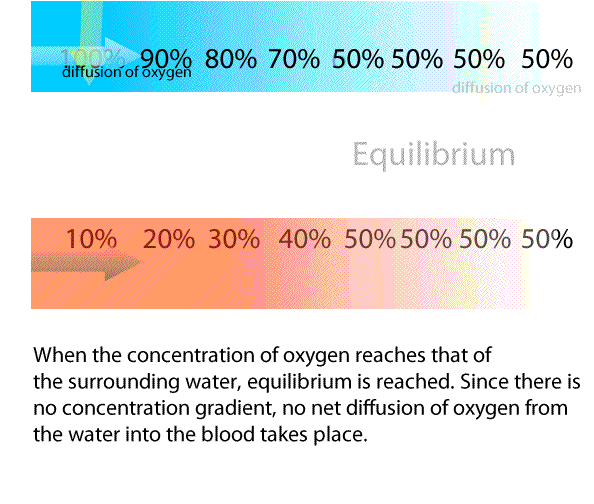Gills are very efficient at taking out what little oxygen is present in the water. This efficiency stems from an adaptation known as countercurrent exchange. Counter current involves blood in the capillaries flowing in the opposite direction to the flow of water flowing over them. Gases diffuse faster from one area to another when the concentration difference between the two areas is at its greatest, as compared to when the concentration difference is low. We say a high concentration gradient exists when the concentration of a substance differs significantly from one area to another.
Consider the animation below the percentage figures refer to the oxygen saturation of the blood or water. In the capillaries of the fish gill, blood with low oxygen concentration travels alongside water with a higher oxygen concentrations. This creates a steep diffusion gradient along the capillary and favors rapid transfer of oxygen into the blood.
Efficiency of the gills is further increased by ventilation,which involves the increase in flow of water over the gills by swimming and by opening and closing their gill flaps. This behaviour draws fresh water into the mouth which passes over the gills.

Click to see agraph of % saturation versus distance blood travels along the capillary
Consider the animation below of a concurrent system. This clearly shows the ineffecient nature of gas exchange as blood and water flow int he same direction. When the concentration of oxygen in the blood and water reach equilibrium the is no concentration gradient to drive diffusion and so no net movement of oxygen into the blood occurs..
At equilibrium equal amount of oxygen moves from the blood to the water as does from water to blood.

Click to see a graph of % saturation versus distance blood travels along the capillary
Explain what is meant by a diffusion gradient. Give an example.
Explain what is meant by a counter current exchange mechanism?
How does a counter current exchange mechanism differ from a concurrent exchange mechanism?
Compare and contrast the concurrent and countercurrent exchange mechanisms and explain why one is more efficient than the other?
Do mammals have a countercurrent exchange mechanism in the alveoli of the lungs? Explain.